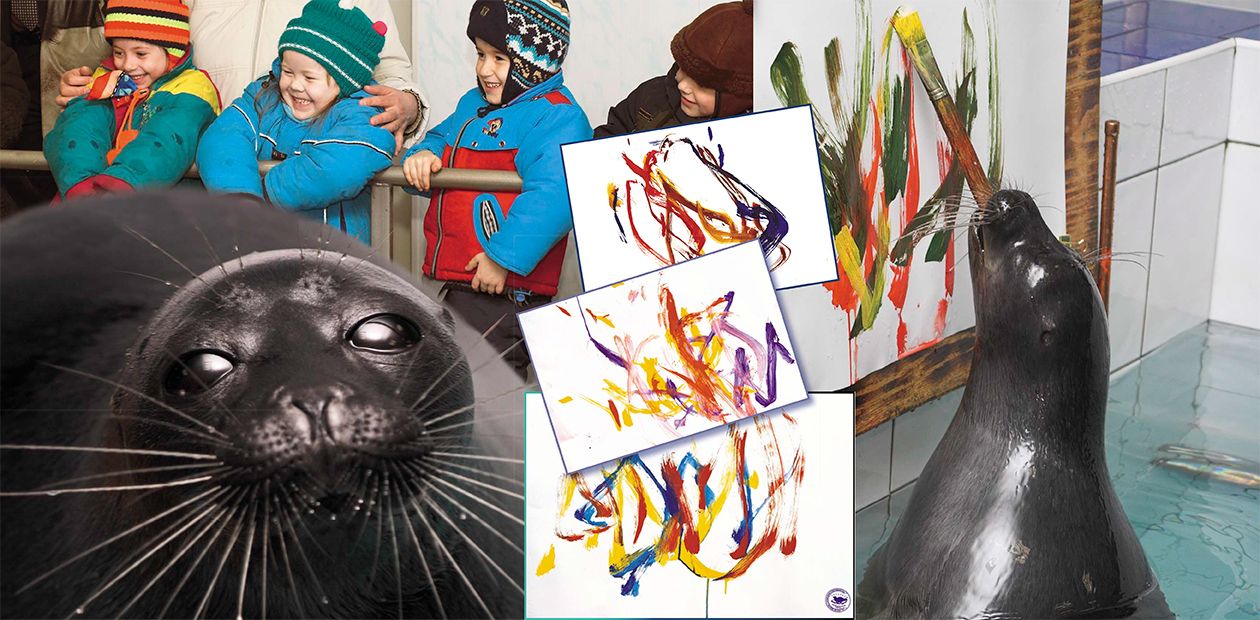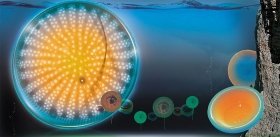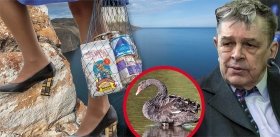Tito the Artist
Our readers met Tito from the Baikal Seal Aquarium when he was just a baby (see Science First Hand, issue 1(2), 2004).
The cub has grown up and learned to draw
Just as Evgeniy Baranov, director of the Baikal Seal Aquarium, steps over the threshold of the auditorium, two dark shadows glide right above the very bottom from the far end of a long pool. Two smart muzzles come up and touch his palms. “Hello, my dears!”
Tito and Nessie are Baikal seals. Tito was named after the first space tourist, and Nessie, after the mysterious inhabitant of the well-known lake. Five days a week, several times a day the seals give amazing performances, stunning the audience with their abilities. They can do a lot of things. For example, a visitor can ask a seal how much is two and three. And the clever animal will eagerly slap the water five times, splashing the inquirer wet. They can neatly salute the show host, like dashing soldiers on parade. They can hilariously imitate starvation by flapping their supposedly empty stomachs with their flippers, which is immediately followed by a piece of fish.
Tito finds great pleasure in kissing Nessie. The seals kiss each other tenderly, their necks stretched out. And if their coach wants it, Tito will kiss her too, while Nessie will be casting jealous glances at them. The coach throws a ball in the water, and they toss it back with their noses right into her hands. Solo and in duo they sing songs about Baikal, exciting a storm of applause. And what great dancers they are! They are always keeping time with music, both on and under the surface. They can spin in sync, like skaters. If you have never seen how dolphins play, the couple will show you: a take-off run, a jump, a smooth arch — and the “dolphin” takes a deep dive. In the wild, seals cannot do that. They cannot touch with their noses a balloon that hangs at about one meter over the water level: the trick must be learned. “Tito, what is now the ecological situation around Baikal?” asks the host. Tito clasps his head in his flippers and shakes it as if he had a toothache.
The seals’ talents are crowned with painting. (It seems that now the term “Lake School” will have more than one meaning in an art encyclopedia.) An easel with clean white paper is fastened to the edge of the pool. The host asks the “master” what he would like to picture today and what paint should be put on the brush. When Tito is in his best form, the strokes of his brush clutched between his teeth are confident and strong. It is evident that he takes great pleasure in painting, sometimes it is hard to stop him. It gives the children a great thrill to watch the seals. They are plunged in a fairy-tale and, mesmerized, they give a name to the latest masterpiece by Tito. The generous artist gives one of his paintings to a child-care center, and another, to our magazine. We thank him very much!
For many years, Baikal seals have been living in the pools of the Limnology Institute, of the Baikal museum, and in similar institutions abroad. The idea of training and teaching the animals came to the candidate of biology E. A. Baranov when he worked for the Limnology Institute of the Siberian Branch of the Russian Academy of Sciences. Here is what he told us:
“Dolphins and ocean seals have been trained for a long time all around the world. As for Baikal seals, nobody tried to do that. I always wanted people to see in the seal not only its expensive silvery skin but also its sharp intellect.
“In Baikal, in their natural habitat, seals do not have enemies. There the seal is the boss, like a bear in the forest. But on the surface, they could always encounter a man with a rifle. That is why seals dread men. When a man stands on ice next to their holes, they will never look out, even though it can cause death of air deficiency in case there is no other hole around. Our colleagues from California believe the Baikal seal to be the most timid creature in the world. The natural caution of the seal was our main obstacle when we tried to become friends.
“After we made friends, it was possible to train them. It turned out that they understood people very well and were happy to do everything they could. And they can do a lot. The main thing is to explain to a seal what you want it to do.
Our first pupil was the five-year-old male Misha. At present, two more seals live and are trained in our old pool in Listvyanka. They are younger than Tito and Nessie but no less talented. If they do not catch up with the older couple, the only reason for that will be that Tito and Nessie will have made even further progress. The seals never get tired: they sleep only three to four hours a day, and in the evening they play as if the day had just started. They seem a little bit disappointed when the last show is over. The painting sessions with animals are not our know-how. We knew that dolphins were quite successful in the activity and offered a paintbrush to Tito. We taught him to hold it, and soon he began to enjoy painting.
“The show of the charismatic inhabitants of the seal pool is an important but not the only part of our work. The radiant smiles and the happy laugh of our visitors are their first step towards knowing Baikal better. After the show we tell them many interesting things about the world’s largest freshwater lake and about the research of our limnologists. And people begin to ask questions that would never come to their mind were it not for the black-eyed pinniped inhabitants of Baikal.”




















